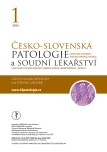Changes in the diagnosis of thyroid tumours in the 5th edition of the WHO classification of endocrine neoplasms
Authors:
Dušková J.
Authors‘ workplace:
Ústav patologie 1. LF UK a VFN, Praha
Published in:
Čes.-slov. Patol., 60, 2024, No. 1, p. 59-63
Category:
Reviews Article
Overview
The WHO classification of thyroid tumours enters its second half-century of development with the 5th edition. Compared to the previous 4th edition of the clas- sification, the permanent increase in information is mainly at the molecular biological level. This has changed the view of very traditional entities – the preferred name for polynodous goiter is (given the monoclonal nature of some nodules) follicular nodular thyroid disease. Some terminological relics have also been re- moved – Hürthle cells are definitively referred to as oncocytes. Follicular adenoma has a new subtype with papillary arrangement (and missing nuclear features of papillary carcinoma). In the already used NIFTP unit, subtypes smaller than 10 mm and oncocytic are newly defined. All oncocytic tumours have an arbitrarily set minimum proportion of oncocytes at 75 %. A multidisciplinary approach to the treatment of thyropathies and the stratification of therapeutic procedures according to risk brought about the introduction of grading into several nosological units of papillary, follicular, and medullary carcinomas. Grading using the number of mitoses determines their quantification at 2 mm² instead of the previously used non-uniform HPFs (high power fields of view). Clarification was made on the basis of genetic findings in a number of other, less frequent diagnoses (e.g. classification of squamous cell carcinoma among anaplastic). Among rare tumors a new category of salivary gland - type carcinomas is formulated with two representatives: mucoepidermoid and secretory carcinoma. Cribriform morular carcinoma previously classified as a variant of papillary carcinoma is newly separated on the basis of the immunological and genetic profile into the newly created category of tumors of uncertain histogenesis. This category also includes sclerosing mucoepidermoid carcinoma with eosinophilia. Microcarcino- ma as a separate entity is not included in the 5th edition. A tumor smaller than 10 mm must be characterized by the appropriate features of the corresponding category. Thyroblastoma replaces terminologically malignant teratoma from the previous classification.
Part of the newly established diagnostic criteria is also applicable in FNAB diagnosis. The newly introduced grading in some nosological units can exceptionally change the diagnosis (NIFTP/EFVPTC/non-invasive HG FVPTC), but above all it will affect the choice of therapeutic procedures.
Keywords:
thyroid nodules – standards – grading – WHO classification of thyroid tumors – thyroid tumors – thyroid biopsy
Sources
- Hedinger C, Sobin LH. Histological typing of thyroid tumours (1 ed.). Geneva: WHO; 1974: 28.
- Hedinger C. Histological typing of thyroid tu- mours. 2nd ed. ed.). Springer; 1988: 80.
- Delellis RA, Lloyd RV, Heitz PU, Eng C, (Eds.):. World health organization classifica- tion of tumours. Pathology & genetics of tu- mours of endocrine organs ed.). Lyon: IARC Press; 2004:
- Ali SZ, Cibas ES. The Bethesda system for re- porting thyroid cytopathology : Definitions, criteria, and explanatory notes ed.). New York: Springer; 2010:
- Lloyd RV, Osamura RY, Klöppel G, Rosai J. WHO classification of tumours of endocrine organs (4th ed.). Lyon: IARC; 2017: 355.
- Ali SZ. The Bethesda system for reporting thyroid cytopathology : Definitions, criteria, and explanatory notes ed.). New York, NY: Springer Science+Business Media; 2018:
- Duskova J. Aktuální otázky tenkojehlové as- pirační biopsie štítné žlázy. Cesk Patol 2019; 55(1): 13-23.
- Dušková J. Aktualizované Bethesda hodno- cení aspiračních biopsií štítné žlázy tenkou jehlou. DMEV 2018; 21(4): 202-209.
- Duskova J. Nový systém pro sjednocené hodnocení tenkojehlových aspiračních bi- opsií štítné žlázy – Bethesda 2010. Cesk Patol 2011; 47(1): 8-14.
- Lloyd RV, Osamura R, Klöppel G, Rossai JE. WHO classification of tumours of endocrine organs (4th ed.). Lyon: IARC; 2017:
- Baloch ZWWHO Classification of Tumours Editorial Board. Endocrine and neuroendo- crine tumours [Internet]. Lyon (France): In- ternational Agency for Research on Cancer; 2022 [cited 2023 08 20]. (WHO classification of tumours series, 5th ed.; vol. 10). Available from: https://tumourclassification.iarc.who. int/chapters/53
- Nosé V, Ericson LA, Lopes MBS, Tischler AS. Diagnostic pathology endocrine (3rd ed.). Philadelphia: Elsevier; 2023: 4-75.
- Gopal RK, Kubler K, Calvo SE, et al. Wide- spread chromosomal losses and mitochon- drial DNA alterations as genetic drivers in Hürthle cell carcinoma. Cancer Cell 2018; 34(2): 242-255
- Gasparre G, Porcelli AM, Bonora E, et al. Disruptive mitochondrial DNA mutations in complex i subunits are markers of oncocytic phenotype in thyroid tumors. Proc Natl Acad Sci U S A 2007; 104(21): 9001-9006.
- Doerfler WR, Nikitski AV, Morariu EM, et al. Molecular alterations in Hürthle cell nodules and preoperative cancer risk. Endocr Relat Cancer 2021; 28(5): 301-309.
- Scognamiglio T, Hyjek E, Kao J, Chen YT. Diagnostic usefulness of HBME1, galectin-3, CK19, and CITED1 and evaluation of their expression in encapsulated lesions with questionable features of papillary thyroid carcinoma. Am J Clin Pathol 2006; 126(5): 700-708.
- Nikiforov YE, Seethala RR, Tallini G, et al. Nomenclature revision for encapsulated fol- licular variant of papillary thyroid carcinoma: A paradigm shift to reduce overtreatment of indolent tumors. JAMA Oncol 2016; 2(8): 1023-1029.
- Yoo SK, Lee S, Kim SJ, et al. Comprehensive analysis of the transcriptional and mutational landscape of follicular and papillary thyroid cancers. PLoS Genet 2016; 12(8): e1006239.
- Wong KS, Chen TY, Higgins SE, et al. A po- tential diagnostic pitfall for hobnail variant of papillary thyroid carcinoma. Histopathology 2020; 76(5): 707-713.
- Najdawi F, Ahmadi S, Capelletti M, et al. Evaluation of grade in a genotyped cohort of sporadic medullary thyroid carcinomas. His- topathology 2021; 79(3): 427-436.
Labels
Anatomical pathology Forensic medical examiner ToxicologyArticle was published in
Czecho-Slovak Pathology

2024 Issue 1
Most read in this issue
- Histopathology of skin melanocytic lesions
- Changes in thyroid cytology reporting in the 3rd edition of the Bethesda system
- Editorial
- Interview
